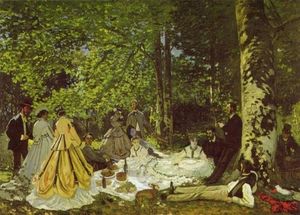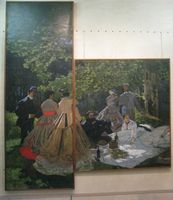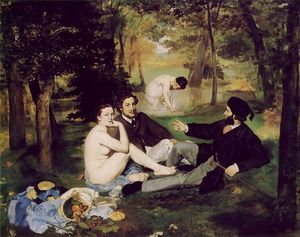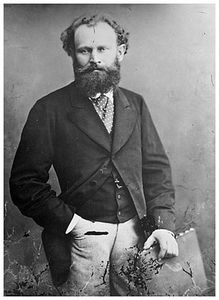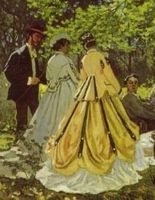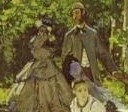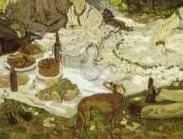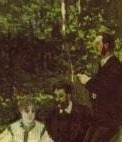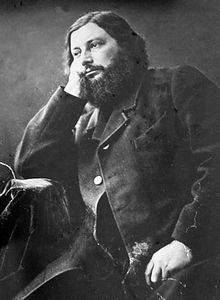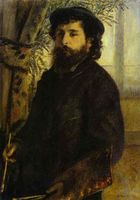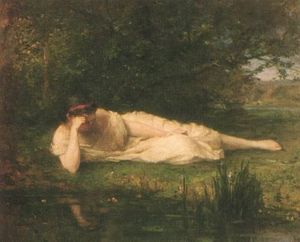Déjeuner sur l'herbe
- Date of Creation:
- 1866
- Height (cm):
- 208.00
- Length (cm):
- 264.00
- Medium:
- Oil
- Support:
- Canvas
- Subject:
- Figure
- Art Movement:
- Impressionism
- Created by:
- Current Location:
- Moscow, Russian Federation
- Displayed at:
- Pushkin Museum of Fine Arts
- Déjeuner sur l'herbe Page's Content
- Story / Theme
- Inspirations for the Work
- Analysis
- Critical Reception
- Artist
- Art Period
- Bibliography
Déjeuner sur l'herbe Story / Theme
Déjeuner sur l'herbe was an immense work of art that was homage to Edouard Manet, who painted a similar themed work only two years previously. Manet's rendition depicted a scene of figures, some clothed and some naked, having a picnic in the woods. The controversial painting was revered by Monet and the thenyoung artist endeavored to paint a similar work on a grander scale.
Monet was said to have a competitive streak and such a personality trait inspired him to start a similar work. The grand work started as a series of sketches which went on to change and shift to the final painted product. Monet's subject was similar to Manet's but subtly different. Instead of the controversy caused by the naked figures in Manet's piece, Monet instead opted for fully clothed figures under the same illumination of natural light.
Monet's work began as a sketch and art historian R. R. Bernier noted about Monet's work that it was a battle between 'the preliminary sketch versus the finished picture'. The initial process of the piece started as sketches in Chailly, with the actual painting by Monet not beginning until he returned to his studio in Paris.
The work sought to portray life size models and such an ambitious project was almost impossible to finish outside. The work wasn't well-received and in the end didn't gain Monet anywhere near as much recognition as his Normandy seascapes. Realist forerunner Gustave Courbet visited Monet's studio to view the work and was said to be highly critical of the yet unfinished piece.
Not only did Monet not finish the work en plein air, he did not finish the work at all. The more than four meter by six project wasn't finished by the 1866 Parlor of the Refused and Monet later abandoned it. Its rolled up form spent years in a cellar, where it grew moldy over time. Today the work only exists as fragments, only two of which have been preserved for public viewing.
The piece; rumored to be a replica, currently resides in The Pushkin Museum of Fine Art, Moscow, Russia as two fragments which are placed together in order to simulate some of Monet's intended completed work.
Déjeuner sur l'herbe Inspirations for the Work
Edouard Manet:
Manet's 1863 work was the main impetus behind Monet embarking on a similar project. Manet's version of the same painting was drawing a great deal of reverence and criticism at the time and it was Monet's endeavor to share in such widespread infamy.
Manet's piece courted such fervor because of its controversial nature. The piece depicted four figures enjoying a picnic. The stark contrast between the clothed and nude figures caused outrage at the time of its exhibition. Monet's homage sought to duplicate some elements of the piece whilst leaving the others.
Monet wanted to combine Manet's elements of a large historical piece in a contemporary scene but without the nudity. The resulting effect wasn't as successful as Manet's Déjeuner sur l'herbe but it stood as a clear example of Monet's diverse talent.
Realism:
Realism and its roots overlapped a great deal with the Impressionist movement. Realist elements of painting clearly influenced Monet and the artist diverged from his usual impressionist brush stroke in order to portray something more akin to the Realist elements in Manet's work.
Déjeuner sur l'herbe Analysis
Composition:
Monet's aim for the Déjeuner sur l'herbe is said to have been an ambitious combination of a variety of painting elements - the natural pastoral setting and an everyday scene with life-sized people.
The impressive scale of the piece means that it draws comparisons between the historical style of large pieces depicting an epic battle or a scene from the bible. Despite not being completed, Monet's work is portrayed in his characteristic masterful artistic flair.
Color palette and use of light:
The en plein air environment makes it a detailed study in the effect of natural light on people and objects. All of Monet's pieces are a study in the uses of light and color and for this reason his use of color is a particular point of interest.
Monet, in his usual artistic flair, is equally adept at depicting shades of black as he is at more complex brighter colors. The column of light emanating from the top of the painting promotes the color of certain aspects of the painting; most notably the trees on the left side which are an eye catching blooming green.
The dark green of the tree leaves on the other side of the painting further illicit this and without depicting any sunlight, Monet's use of color is giving the viewer some idea of where the sun is in relation to his scene.
The biggest section of white in the piece stems from the picnic mat in the centre and its pristine white, accentuated further by the white dresses of the two female figures sitting around it instantly draw the gaze. There are other women clad in white to the left, but under the trees shade the whites of their dresses appear sullen and a great deal more subdued.
The figures to the side of the piece look noticeably different to those in the middle, in terms of lightness of color. The ground in the piece is also split along the lines of light and dark, with the vibrant greens of the left side of the tree line matching exactly that of the grass behind the figures in Monet's piece.
The primary colors for the pieces are shades of green, white and black and such a simple formation of colors concentrates the viewer's eyes on the scenery as much as the figures that reside in it.
Perspective:
Unlike many of Monet's work the perspective for the piece places the viewers gaze directly in the centre of the work. This is reinforced by the composition, lighting and use of color. The primary source of light is at the center of the piece and draws the viewer's attentions. It is also where the food and drinks are and as the piece is titled 'Picnic on the grass' it instantly focuses the viewer's attention.
Monet's perspective is so close to the scene that it makes the viewer feel part of the piece, as the thirteenth guest of the picnic.
Déjeuner sur l'herbe Critical Reception
Monet famously painted Déjeuner sur l'herbe in reaction to Edouard Manet's painting of a similar name. Manet's piece was garnering a lot of attention in the Salon Des Refusés at the time of Monet's decision to paint a similar piece and a young, impressionable Monet believed that his work would attract similar attention.
Monet's Déjeuner sur l'herbe was never finished and subsequently its contemporary criticism is limited. Even in its unfinished form however, its reception amongst fellow artists was scathing. Realism founder Gustave Courbet famously visited Monet's Paris studio and was notably critical of the work in progress.
If Monet completed his ambitious work it more than likely would have been refused by the Paris Salon. The 1860s in France was a particularly turbulent term in terms of transitions between art movements. Realism and Impressionism were vibrantly different to anything that had come previously and the artistic institutions had a great deal of difficulty accepting these new movements.
In 1863 the Paris Salon, which was the only real way artists could exhibit works rejected more than 4000. In response Napoleon III opened the Salon des Refusés, which exhibited many of the works which had been rejected by the Paris Salon.
Déjeuner sur l'herbe Artist
Monet was only 25 years old when he decided to try and paint a work on a similar scale to Edouard Manet's Le déjeuner sur l'herbe. Monet was heavily influenced by the fame and infamy that went with Manet's piece and his ambition was to cement his own reputation by painting a similar piece.
Monet's landscape works of beaches had been steadily gaining him an increasingly good reputation amongst many in the traditional art circles and Déjeuner sur l'herbe was meant to increase this. The piece wasn't a success however and its unfinished canvases were left abandoned for many years.
Déjeuner sur l'herbe Art Period
Claude Monet painted Déjeuner sur l'herbe at a time when the Realist and Impressionist movement had began to overlap. Impressionism was to some degree inspired by Realism and many artists, including Edouard Manet, utilized elements from both movements to create works that were unique and usually well-received.
Déjeuner sur l'herbe Bibliography
To read more about Claude Monet and his artworks please choose from the following recommended sources.
• Wildenstein, Daniel. Monet or the Triumph of Impressionism. Taschen GmbH, 2010
• Monet, Claude & Metropolitan Museum of Art. Monet's Impressions. Chronicle Books, 2009
• Patin, Sylvie & Roberts, Anthony. Monet: The Ultimate Impressionist (New Horizons). Thames & Hudson, 1993
• Russell, Vivian. Monet's Garden: Through the Seasons at Giverny: Behind the Scenes and Through the Seasons. Frances Lincoln, 1995
• Rey, Jean-Dominique & Rouart, Denis. Monet: Water Lilies: The Complete Series. Flammarion, 2008
• Monet, Claude. Monet by Himself. Little, Brown & Company, 2000

